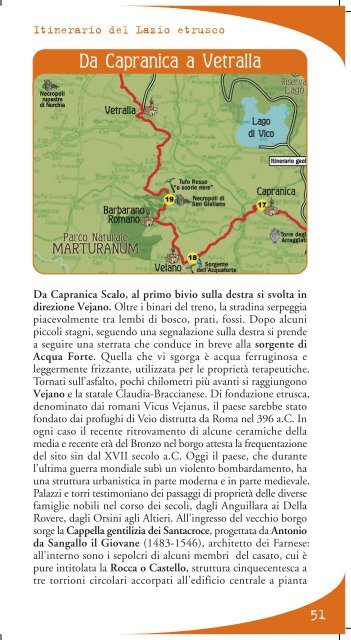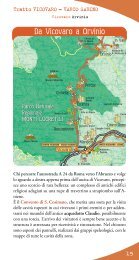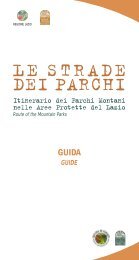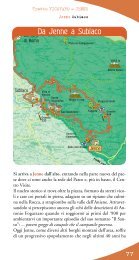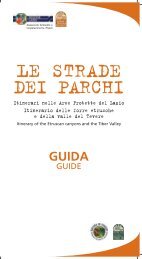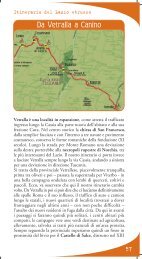Guida - Le Strade dei Parchi
Guida - Le Strade dei Parchi
Guida - Le Strade dei Parchi
Create successful ePaper yourself
Turn your PDF publications into a flip-book with our unique Google optimized e-Paper software.
Itinerario del Lazio etrusco<br />
Da Capranica a Vetralla<br />
Da Capranica Scalo, al primo bivio sulla destra si svolta in<br />
direzione Vejano. Oltre i binari del treno, la stradina serpeggia<br />
piacevolmente tra lembi di bosco, prati, fossi. Dopo alcuni<br />
piccoli stagni, seguendo una segnalazione sulla destra si prende<br />
a seguire una sterrata che conduce in breve alla sorgente di<br />
Acqua Forte. Quella che vi sgorga è acqua ferruginosa e<br />
leggermente frizzante, utilizzata per le proprietà terapeutiche.<br />
Tornati sull’asfalto, pochi chilometri più avanti si raggiungono<br />
Vejano e la statale Claudia-Braccianese. Di fondazione etrusca,<br />
denominato dai romani Vicus Vejanus, il paese sarebbe stato<br />
fondato dai profughi di Veio distrutta da Roma nel 396 a.C. In<br />
ogni caso il recente ritrovamento di alcune ceramiche della<br />
media e recente età del Bronzo nel borgo attesta la frequentazione<br />
del sito sin dal XVII secolo a.C. Oggi il paese, che durante<br />
l’ultima guerra mondiale subì un violento bombardamento, ha<br />
una struttura urbanistica in parte moderna e in parte medievale.<br />
Palazzi e torri testimoniano <strong>dei</strong> passaggi di proprietà delle diverse<br />
famiglie nobili nel corso <strong>dei</strong> secoli, dagli Anguillara ai Della<br />
Rovere, dagli Orsini agli Altieri. All'ingresso del vecchio borgo<br />
sorge la Cappella gentilizia <strong>dei</strong> Santacroce, progettata da Antonio<br />
da Sangallo il Giovane (1483-1546), architetto <strong>dei</strong> Farnese:<br />
all'interno sono i sepolcri di alcuni membri del casato, cui è<br />
pure intitolata la Rocca o Castello, struttura cinquecentesca a<br />
tre torrioni circolari accorpati all'edificio centrale a pianta<br />
51
52<br />
Itinerario del Lazio etrusco<br />
Capranica Vetralla<br />
triangolare, forse fatta erigere a fine Quattrocento da papa<br />
Alessandro VI. All'età romana imperiale, invece, appartiene una<br />
grandiosa villa in località Fontiloro. Dalla statale una deviazione<br />
porta in poco tempo a Barbarano Romano. Il paese sorge su<br />
un pianoro tufaceo di forma triangolare, protetto per due lati<br />
dal torrente Biedano e da un suo affluente, per il terzo da<br />
imponenti mura d’età medievale. L’ingresso è per la maestosa<br />
Porta Romana, un tempo dotata di ponte levatoio. In epoca<br />
romana passava di qui il tracciato della via Clodia, in parte<br />
riportato alla luce negli anni Ottanta. Tra vicoli e piazze da<br />
vedere c’è il Museo archeologico, che espone reperti in buona<br />
parte provenienti dalla vicina necropoli di San Giuliano, come<br />
il corredo della tomba Cima con vasi attici a figure nere di<br />
provenienza greca. Ed è proprio la necropoli il maggior motivo<br />
di interesse, il cuore del parco naturale regionale di Marturanum.<br />
La necropoli di S.Giuliano<br />
Secondo gli archeologi, nessuna necropoli etrusca conosciuta<br />
presenta una varietà e ricchezza di tipi sepolcrali come San<br />
Giuliano. Risalente ai secoli VI-VII a.C., sorge sui fianchi<br />
di una rupe tufacea occupata da un insediamento stabile già<br />
durante il Villanoviano recente (alla fine dell’VIII secolo a.C.).<br />
Ma è durante il VI secolo a.C. che la città di Marturanum<br />
conobbe il massimo splendore, favorita dalla sua posizione<br />
naturalmente fortificata sulla via che da Cerveteri conduceva<br />
a Orvieto, fino a diventare l’avamposto della potente Tarquinia<br />
verso Roma. Tagliando il pianoro subito oltre la staccionata,
Itinerario del Lazio etrusco<br />
Capranica Vetralla<br />
dove sorge anche la piccola chiesa medievale di San Giuliano<br />
anch’essa in tufo, si giunge ad un punto panoramico affacciato<br />
sul sottostante vallone. Qui le prime tombe visitabili, bellissime,<br />
sono il Tumulo del Caiolo e le tombe cosiddette <strong>dei</strong> Carri e<br />
<strong>dei</strong> <strong>Le</strong>tti. Poi seguendo il sentiero che scende nel vallone<br />
s’incontrano via via le altre, a partire dalle tombe dette<br />
Palazzine, senza mancare di osservare il solitario ambiente del<br />
fosso che scorre tra felci e sotto le chiome degli alberi.<br />
Una tabella segnala la tomba più monumentale, quella della<br />
Regina, con la facciata alta dieci metri, mentre la non lontana<br />
tomba del Cervo presenta sopra una gradinata laterale una<br />
singolare scultura a bassorilievo: rappresenta la lotta tra un<br />
cervo e un lupo ed è stata scelta dal parco come logo stilizzato<br />
dell’area protetta.<br />
Tornati all’ingresso del paese, si trova il Museo naturalistico del<br />
parco con attiguo centro visite. Al bivio poco più avanti, in<br />
corrispondenza del cimitero, viene poi segnalata una necropoli<br />
etrusca: è appunto quella di San Giuliano, per raggiungere la<br />
quale occorre percorrere la strada per alcuni chilometri arrivando<br />
alla segnalata area del Caiolo. Si tratta di un’area attrezzata dal<br />
parco con parcheggio e panchine, fontana, gabbiotto in legno<br />
che funziona da punto informativo. Da qui a piedi si effettua la<br />
visita alla straordinaria necropoli, con decine di tombe disseminate<br />
sul bordo del pianoro e sui fianchi della sottostante forra.<br />
Dopo il Caiolo si riprende la strada asfaltata verso sinistra, ed<br />
in breve si è ad un bivio dove andando a destra raggiungiamo<br />
Vetralla, anzi prima la sua frazione Pietrara dov’è un bellissimo<br />
querceto attrezzato con aree picnic.<br />
53
54<br />
The Itinerary of Etruscan Lazio<br />
From Capranica to Vetralla<br />
From Capranica Scalo, at the first intersection on the right, turn in the direction<br />
of Vejano. On the other side of the railway tracks, the road winds pleasantly through<br />
patches of woods, meadows, streams. After you go past some small ponds and following<br />
the signs, turn right on a dirt road which in a short time reaches the Acqua Forte<br />
spring. The water of this spring is ferruginous and slightly sparkling and is used for<br />
its therapeutic properties. When you get back onto the paved asphalt road, just a few<br />
kilometers ahead you reach Vejano and the Claudia-Braccianese state highway.<br />
Vejano was probably founded by the Etruscans when the refugees from Veio settled<br />
there when Veio was destroyed by Rome in 396 B.C. The Romans called it Vicus<br />
Vejanus. Vejano was heavily bombed during World War II and it is now partially<br />
modern and partially medieval. Noble buildings and towers bear witness to the<br />
handing down of ownership among the various noble families over the centuries, from<br />
the Anguillara family to the Della Rovere family to the Orsini family to the Altieri<br />
family. From the state highway take a turnoff that brings you in a short time to<br />
Barbarano Romano. The city rises on a triangular shaped tufaceous plateau which<br />
is protected on two sides by the Biedano stream and one of its tributaries. On the<br />
third side it is protected by its imposing medieval walls. You enter the town through<br />
its majestic gate, Porta Romana, which at one time had a drawbridge. During<br />
Roman times Via Clodia passed through here and in the 1980’s part of the paving<br />
was discovered. While walking along the streets and squares you can see the Museo<br />
Archeologico which displays finds mostly from the nearby necropolis of San Giuliano<br />
such as the tomb furnishings of the Cima tomb with black-figured Attic vases of Greek<br />
origin. The necropolis is the main point of interest in the heart of Marturanum<br />
nature park. When you return to the town entrance, you can find the nature museum<br />
of the park with its adjacent visitor center. Just a short distance ahead at an intersection<br />
near the cemetery there is a sign for an Etruscan necropolis. This is the San Giuliano<br />
necropolis and you have to drive along the road for several kilometers until you reach<br />
the marked area of Caiolo. Caiolo is a park that has a parking lot, benches, a<br />
fountain, and a little wooden building used as an information center. From this<br />
point you have to walk to see the extraordinary necropolis with dozens of tombs<br />
scattered along the plateau and along the edges of the gorge below. From Caiolo get<br />
back onto the paved road and go left and in a short time you will reach an intersection<br />
where you turn right to reach Vetralla. Actually, first you reach the village of Pietrara<br />
where there is a beautiful oak grove equipped with a picnic area.<br />
tombe etrusche della Necropoli di San Giuliano
Il parco naturale di Marturanum<br />
I<br />
stituita dalla Regione Lazio nel 1984,<br />
l’area protetta si estende per 1240 ettari<br />
nella parte più meridionale del viterbese<br />
nel territorio <strong>dei</strong> Comuni di Barbarano<br />
Romano e Blera. L’origine del territorio è<br />
prevalentemente vulcanica, incontrandosi<br />
qui i tufi emessi dall’antico apparato vicano<br />
con le argille e i calcari marnosi (dai geologi<br />
questa roccia è definita flysch) del<br />
comprensorio <strong>dei</strong> monti della Tolfa. Il settore più settentrionale<br />
del parco è caratterizzato da profondi valloni scavati nel tufo<br />
dal fiume Biedano e dai suoi affluenti. E’ il regno della vegetazione<br />
igrofila, e comunque di piante caratteristiche <strong>dei</strong> climi umidi<br />
e freschi come nocciolo, pioppo bianco e nero, salice, ontano.<br />
Nel sottobosco abbondano le ortiche, il farfaraccio, 1'edera ma<br />
soprattutto le felci: dalla lingua cervina allo Scolopendrium, alla<br />
bella Osmunda regalis, appartengono a specie numerose e<br />
colonizzano tanto le sponde <strong>dei</strong> fossi che l’apertura delle tombe<br />
etrusche. Più a meridione si trova invece un’ampia zona collinare,<br />
che degrada verso il corso del torrente Vesca, affluente del<br />
Mignone. Qui la migliore insolazione e i calcari marnosi e<br />
argillosi sono alla base di paesaggi ben differenti, cioè ampi<br />
pascoli cespugliati utilizzati dal bestiame brado e caratteristici<br />
della campagna maremmana. S’incontrano querce come il leccio,<br />
la roverella, il cerro con un sottobosco fitto e intricato dov’è<br />
frequente la presenza di specie come l’agrifoglio, lo stracciabrache,<br />
il lentisco e, nelle radure e ai margini delle macchie, orchidee<br />
selvatiche in buona varietà.<br />
Il popolamento animale non è più ricco come un tempo, ma<br />
rimane abbastanza diversificato. Tra i mammiferi, non è difficile<br />
rinvenire i segni di presenza dell’istrice, del tasso, dell’ormai<br />
ubiquitario cinghiale: si tratta di volta in volta di aculei, peli,<br />
feci, impronte nel terreno umido. Specie ancora più delicate e<br />
dunque utilizzate come indicatori ecologici sono anfibi quali la<br />
salamandrina dagli occhiali oppure crostacei come granchi e
gamberi di fiume. Nelle zone aperte lo scenario mura radicalmente.<br />
I campi sono l’habitat ideale di passeriformi sempre più rari<br />
come la calandra, o delle più comuni allodola e cappellaccia,<br />
mentre tra i rapaci si possono osservare albanelle minori, il<br />
biancone, il nibbio reale. Cervone e testuggine comune sono<br />
tra i rettili censiti, ma è senz’altro più facile l’osservazione della<br />
volpe, oggi il mammifero predatore più diffuso del Lazio.<br />
particolare del tufo rosso a scorie nere della Necropoli di San Giuliano<br />
Marturanum nature park<br />
The Marturanum protected area is spread over 1240 hectares in the southernmost<br />
part of the Viterbo province. The northernmost part of the park has deep valleys<br />
hollowed out of the tuff by the Biedano stream and its tributaries. The undergrowth<br />
of the woods is covered with nettles, butter-burr, and ivy but above all with ferns.<br />
Further south there is a large hilly area which slopes down to the Vesca stream,<br />
a tributary of the Mignone River. Here the nature of the landscape is very different<br />
because it receives better sunlight and rests on calcium carbonate muds and<br />
argillaceous limestone. There are large pasture areas with shrubs, characteristic<br />
of the Maremma countryside, which are used by the free-range cattle.<br />
There aren’t as many animals in this area as there were in the past but there is<br />
still a rather large number of species. Among the mammals, it’s not unusual to<br />
see signs of porcupines, badgers, and the ubiquitous boar. Species which are more<br />
delicate and are environmental indicators are amphibians such as the spectacled<br />
salamander or crustaceans such as river crabs and crayfish.<br />
In the open areas, the fields are the ideal habitat for Passeriformes which are ever<br />
more rare such as the calandra lark or the more common skylark and crested lark<br />
whereas among birds of prey you can see short-toed eagles, Montagu’s harrier, and<br />
red kite. The most common reptiles found are the tortoise and the four-lined snake<br />
but it is certainly easier to see a fox than these animals since the fox is the most<br />
widespread predator in Lazio.
Informazioni utili Useful information<br />
TRATTO<br />
CAPRANICA - VETRALLA<br />
Parco regionale Marturanum<br />
Sede del Parco / Park offices<br />
Piazza G. Marconi 21, Barbarano Romano (VT)<br />
Tel. 0761 414601 - www.parchilazio.it, www.parks.it<br />
Ricettività e ristorazione / Accomodation and restaurants<br />
BARBARANO<br />
Albergo Ristorante Marturanum Viale IV Novembre, 2 - Tel 0761 414368<br />
Agriturismo “Dimensione Avventura”<br />
Loc. La Fontanaccia - Tel. 328 4787388 - 338 4023923<br />
Bar Trattoria La Pacchiana Tel. 0761 414633 - Fax 0761 414349<br />
BLERA<br />
Agriturismo “Etrusca Country” - Loc. Civitella Cesi<br />
Tel. 0761 415022 - www.etruscacountry.com<br />
Bed & Breakfast “Il Portale” - Vicolo del Pavone 7<br />
Tel. 0761 479388<br />
CAPRANICA<br />
Bed & Breakfast “Il Profeta” - Loc. Vico Matrino<br />
Tel. 0761 678865 - www.ilprofeta.biz<br />
Bed & Breakfast “Al Casale Giallo” - Via Campo Spinella<br />
Tel. 0761 660480 - www.anbba.it/alcasale/giallo<br />
Bed & Breakfast “Il Quadrone” - Strada Quadrone snc<br />
Tel. 0761 669875 - www.ilquadrone.com<br />
Camping Natura - Via Romeo Tacchi<br />
Tel. 0761 612347 - www.camping-natura.com<br />
Prodotti tipici / Local products<br />
Carne di bovino maremmano<br />
Manifestazioni, feste e sagre / Events, festival and fairs<br />
17 gennaio: Sant’Antonio Abate<br />
Pasqua: Processione del Cristo Morto<br />
Prima domenica di maggio: “Attozzata”, pranzo in campagna<br />
a base di ricotta fresca e pane<br />
17 giugno: Corpus Domini, con Infiorata per le vie del paese<br />
8/9/10 settembre: Natività della Madonna<br />
4 dicembre: festa di Santa Barbara, patrona di Barbarano<br />
Parco regionale Marturanum<br />
87


